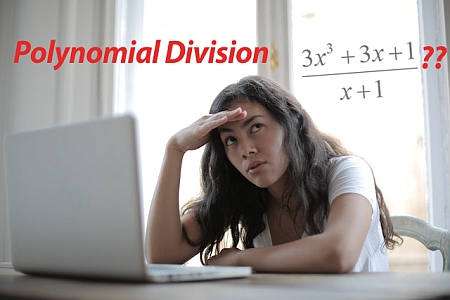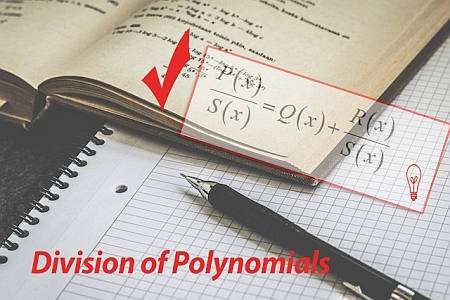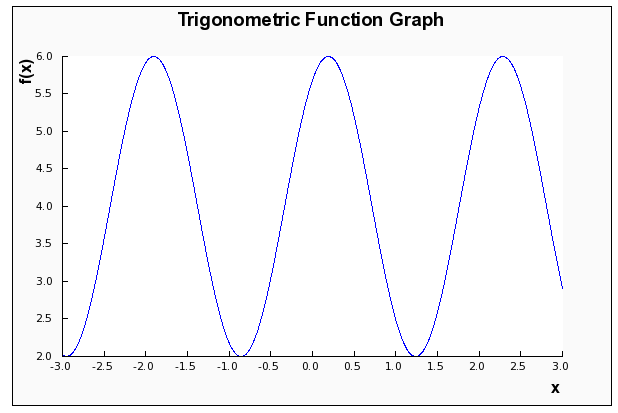Polynomial Division
Instructions: Use polynomial division calculator to divide two polynomials you provide showing all the steps. Please type in the two polynomials in the form box below.
Polynomial Division
This calculator will conduct a polynomial division for you, and all you have to do is to provide two valid polynomials. The order these polynomials are given matters, since polynomial division is not commutative (so then p(x)/s(x) is not the same as s(x)/p(x)).
The first polynomial you provide, often called the dividend, corresponds to the dividend, and the second polynomial is the one you are dividing by, usually called the divisor.
Examples of valid polynomials are p(x) = x^4 + 3x^3 - 2 and s(x) = x - 3, but the polynomial coefficients do not have to be integers, as they can be fractions, or any kind of valid numeric expression. Also, the polynomials do not have to come simplified. If needed, the calculator will conduct a polynomial simplification before dividing.
Once you provide the valid polynomials, then you are all set. All that is left to do is to click on "Calculate", so you can get all the steps of the process shown.

How to divide polynomials
Polynomial division is slightly more complicated than the dividing numbers. For example, when we divide two numbers like '4 divided by 2', we do 4/2 = 2. So it is easy, right?
But it is not always as easy, because we can have something like '7/2'. You can say 'well, 7/2 = 3.5' and you would be correct, but other way of seeing is to say that '7 divided by 2 is 3, with a remainder of 1'. Why? Because there is no integer such that multiplying by 2 reaches 7. The closest is 3, so that \(2 \cdot 3 = 6\), but I have a remainder of 1
Exactly the same idea applies for polynomial division. Given a polynomial \(p(x)\) and a divisor \(s(x)\) we will try to find a quotient \(q(x)\) such that
\[\displaystyle p(x) = s(x) \cdot q(x)\]but we won't always be able to, in the same way as for '7/2' we could not find an exact division. Then, we will identify the remainder \(r(x)\), which is the polynomial that accounts how much \(s(x) \cdot q(x)\) "misses" when aiming for p(x). So we write
\[\displaystyle p(x) = s(x) \cdot q(x) + r(x)\]Ideally, we want \(r(x)\) to be zero, and if not, we want it to be a small as possible. The algorithm of Euclid shows us how to find the smallest possible \(r(x)\) and if things go right, it could be zero, in which case we say that the divisor \(s(x)\) divides the polynomial \(p(x)\).
What are the steps of polynomial division?
- Step 1: Identify the dividend p(x) and the divisor s(x). Make sure to simplify them as much as possible before proceeding
- Step 2: If the degree of s(x) is greater than the degree of p(x), stop, in this case the quotient is zero and remainder is p(x)
- Step 3: If you did not stop in step 2, take note of the leading term of the divisor, and the leading term of the dividend
- Step 4: Find the division between the leading terms of the dividend and divisor (this is interpreted as what term you need to multiply the leading term of the divisor to get to the leading term of the dividend), and this will be the current factor, which will be added to the current quotient
- Step 5: Multiply the current factor by the divisor, and the result, subtract it to the dividend, this way creating a new current dividend
- Step 6: Repeat this process until the current dividend has a degree that is less than the divisor. Then stop, you current divisor will be your remainder
This process is guaranteed to work since the current dividend reduces its degree at least by one on each step. Clever, huh?.
What method to use, long division or synthetic division?
Synthetic division is used in the special case that the divisor has degree one. For example s(x) = x - 1, but it would not work for s(x) = x^2 - 1 although there are versions of the synthetic division algorithm for higher degrees. Synthetic division is typically restricted to divisors of degree 1 because of its intimate association with synthetic substitution and the remainder theorem, it does make sense.
Long division will happen in most cases, when synthetic division is not applicable. Notice that synthetic division uses a long division method, only that it is adapted to be super quick, so that is why it is the preferred way when possible.
How to use polynomial division to solve polynomial equations?
- Step 1: Identify your polynomial equation, and make sure that each side of the equation is indeed a valid polynomial
- Step 2: Pass all the terms on one side to the other side by changing the signs
- Step 3: Group all terms on one side and simplify
- Step 4: Now you have a polynomial equation in which one side is a polynomial, and the other side is 0, so it is solving by factoring the corresponding polynomial
- Step 5: First, you try with the rational root theorem to attempt to find simple roots
- Step 6: Group the simple roots, create corresponding linear terms associated (ex: if x = 1 is a solution, form the term x - 1), multiply them and divide the polynomial by it. This way, you will obtain a quotient of lower order
- Step 7: Repeat the steps with the quotient of lower order found in the previous steps
As you can see, there are no shortcuts or magic formulas for finding the roots of polynomials. But there is a systematic procedure that can increase your chances of finding the roots as easily as possible.
Why would care about dividing polynomials
Precisely because polynomial division is your key to finding roots to polynomial equations, which are one of the central topics of Algebra.

Example: Polynomial division calculation
Calculate the following division: \(\frac{3x^3+3x+3}{3x+1}\)
Solution:In this case, from the division provided we have that the dividend is \(\displaystyle p(x) = 3x^3+3x+3\), and the divisor is \(\displaystyle s(x) = 3x+1\).
In this case, the degree of the dividend is \(\displaystyle deg(p) = 3\), whereas the degree of the divisor is \(\displaystyle deg(s)) = 1\).
Step 1: The leading term of the dividend \(\displaystyle p(x) = 3x^3+3x+3\) is \(\displaystyle 3x^3\), whereas the leading term for the divisor \(\displaystyle s(x) = 3x+1\) is equal to \(\displaystyle 3x\).
So then, the term we need to multiply \(3x\) to get to the leading term of the dividend is \(\displaystyle \frac{ 3x^3}{ 3x} = x^2\), so we add this term to the quotient. Also, we multiply this by the divisor to get \(\displaystyle x^2 \cdot \left(3x+1\right) = 3x^3+x^2\), which we need to subtract to the dividend:
\[\begin{array}{rcccc} &\displaystyle x^2 & \displaystyle & \displaystyle &\\[0.8em] \hline 3x+1\,) & \displaystyle 3x^3 & \displaystyle & \displaystyle +3x & \displaystyle +3\\[0.8em] \displaystyle &\displaystyle -3x^3 & \displaystyle -x^2 & \displaystyle & \displaystyle \\[0.8em] \hline \displaystyle &\displaystyle & \displaystyle -x^2 & \displaystyle +3x & \displaystyle +3\\[0.8em] \end{array}\]Step 2: Now, the leading term of the current remainder \(\displaystyle -x^2+3x+3\) is \(\displaystyle x^2\), and we know the leading term for the divisor is \(\displaystyle 3x\).
So then, the term we need to multiply \(3x\) to get to the leading term of the of current remainder is \(\displaystyle \frac{ -1x^2}{ 3x} = -\frac{1}{3}x\), so we add this term to the quotient. Also, we multiply this by the divisor to get \(\displaystyle -\frac{1}{3}x \cdot \left(3x+1\right) = -x^2-\frac{1}{3}x\), which we need to subtract to the current reminder:
\[\begin{array}{rcccc} &\displaystyle x^2 & \displaystyle -\frac{1}{3}x & \displaystyle &\\[0.8em] \hline 3x+1\,) & \displaystyle 3x^3 & \displaystyle & \displaystyle +3x & \displaystyle +3\\[0.8em] \displaystyle &\displaystyle -3x^3 & \displaystyle -x^2 & \displaystyle & \displaystyle \\[0.8em] \hline \displaystyle &\displaystyle & \displaystyle -x^2 & \displaystyle +3x & \displaystyle +3\\[0.8em] \displaystyle &\displaystyle & \displaystyle x^2 & \displaystyle +\frac{1}{3}x & \displaystyle \\[0.8em] \hline \displaystyle &\displaystyle & \displaystyle & \displaystyle \frac{10}{3}x & \displaystyle +3\\[0.8em] \end{array}\]Step 3: Now, the leading term of the current remainder \(\displaystyle \frac{10}{3}x+3\) is \(\displaystyle \frac{10}{3}x\), and we know the leading term for the divisor is \(\displaystyle 3x\).
So then, the term we need to multiply \(3x\) to get to the leading term of the of current remainder is \(\displaystyle \frac{ \frac{10}{3}x}{ 3x} = \frac{10}{9}\), so we add this term to the quotient. Also, we multiply this by the divisor to get \(\displaystyle \frac{10}{9} \cdot \left(3x+1\right) = \frac{10}{3}x+\frac{10}{9}\), which we need to subtract to the current reminder:
\[\begin{array}{rcccc} &\displaystyle x^2 & \displaystyle -\frac{1}{3}x & \displaystyle +\frac{10}{9}&\\[0.8em] \hline 3x+1\,) & \displaystyle 3x^3 & \displaystyle & \displaystyle +3x & \displaystyle +3\\[0.8em] \displaystyle &\displaystyle -3x^3 & \displaystyle -x^2 & \displaystyle & \displaystyle \\[0.8em] \hline \displaystyle &\displaystyle & \displaystyle -x^2 & \displaystyle +3x & \displaystyle +3\\[0.8em] \displaystyle &\displaystyle & \displaystyle x^2 & \displaystyle +\frac{1}{3}x & \displaystyle \\[0.8em] \hline \displaystyle &\displaystyle & \displaystyle & \displaystyle \frac{10}{3}x & \displaystyle +3\\[0.8em] \displaystyle &\displaystyle & \displaystyle & \displaystyle -\frac{10}{3}x & \displaystyle -\frac{10}{9}\\[0.8em] \hline \displaystyle &\displaystyle & \displaystyle & \displaystyle & \displaystyle \frac{17}{9}\\[0.8em] \end{array}\]which consequently ends the process.
Conclusion: Therefore, we conclude that for the given dividend \(\displaystyle p(x) = 3x^3+3x+3\) and divisor \(\displaystyle s(x) = 3x+1\), we get that the quotient is \(\displaystyle q(x) = x^2-\frac{1}{3}x+\frac{10}{9}\) and the remainder is \(\displaystyle r(x) = \frac{17}{9}\), and that
\[\displaystyle \frac{p(x)}{s(x)} = \frac{3x^3+3x+3}{3x+1} = x^2-\frac{1}{3}x+\frac{10}{9} + \frac{\frac{17}{9}}{3x+1}\]Example: Another division of polynomials
Calculate the division of the dividend \(\frac{1}{3} x^4 - x^3 + 2x - \frac{5}{6}\) and divisor \(s(x) = 3x+1\)
Solution: In this case we have been provided: \(\displaystyle p(x) = \frac{1}{3}x^4-x^3+2x-\frac{5}{6}\), which needs to be divided by the polynomial \(\displaystyle s(x) = 3x+1\).
Now, the degree of the dividend is \(\displaystyle deg(p) = 4\), and the degree of the divisor is \(\displaystyle deg(s)) = 1\).
Step 1: The leading term of the dividend \(\displaystyle p(x) = \frac{1}{3}x^4-x^3+2x-\frac{5}{6}\) is \(\displaystyle \frac{1}{3}x^4\), whereas the leading term for the divisor \(\displaystyle s(x) = 3x+1\) is equal to \(\displaystyle 3x\).
So then, the term we need to multiply \(3x\) to get to the leading term of the dividend is \(\displaystyle \frac{ \frac{1}{3}x^4}{ 3x} = \frac{1}{9}x^3\), so we add this term to the quotient. Also, we multiply this by the divisor to get \(\displaystyle \frac{1}{9}x^3 \cdot \left(3x+1\right) = \frac{1}{3}x^4+\frac{1}{9}x^3\), which we need to subtract to the dividend:
\[\begin{array}{rccccc} &\displaystyle \frac{1}{9}x^3 & \displaystyle & \displaystyle & \displaystyle &\\[0.8em] \hline 3x+1\,) & \displaystyle \frac{1}{3}x^4 & \displaystyle -x^3 & \displaystyle & \displaystyle +2x & \displaystyle -\frac{5}{6}\\[0.8em] \displaystyle &\displaystyle -\frac{1}{3}x^4 & \displaystyle -\frac{1}{9}x^3 & \displaystyle & \displaystyle & \displaystyle \\[0.8em] \hline \displaystyle &\displaystyle & \displaystyle -\frac{10}{9}x^3 & \displaystyle & \displaystyle +2x & \displaystyle -\frac{5}{6}\\[0.8em] \end{array}\]Step 2: In this case, the leading term of the current remainder \(\displaystyle -\frac{10}{9}x^3+2x-\frac{5}{6}\) is \(\displaystyle -\frac{10}{9}x^3\), and we know the leading term for the divisor is \(\displaystyle 3x\).
So then, the term we need to multiply \(3x\) to get to the leading term of the of current remainder is \(\displaystyle \frac{ -\frac{10}{9}x^3}{ 3x} = -\frac{10}{27}x^2\), so we add this term to the quotient. Also, we multiply this by the divisor to get \(\displaystyle -\frac{10}{27}x^2 \cdot \left(3x+1\right) = -\frac{10}{9}x^3-\frac{10}{27}x^2\), which we need to subtract to the current reminder:
\[\begin{array}{rccccc} &\displaystyle \frac{1}{9}x^3 & \displaystyle -\frac{10}{27}x^2 & \displaystyle & \displaystyle &\\[0.8em] \hline 3x+1\,) & \displaystyle \frac{1}{3}x^4 & \displaystyle -x^3 & \displaystyle & \displaystyle +2x & \displaystyle -\frac{5}{6}\\[0.8em] \displaystyle &\displaystyle -\frac{1}{3}x^4 & \displaystyle -\frac{1}{9}x^3 & \displaystyle & \displaystyle & \displaystyle \\[0.8em] \hline \displaystyle &\displaystyle & \displaystyle -\frac{10}{9}x^3 & \displaystyle & \displaystyle +2x & \displaystyle -\frac{5}{6}\\[0.8em] \displaystyle &\displaystyle & \displaystyle \frac{10}{9}x^3 & \displaystyle +\frac{10}{27}x^2 & \displaystyle & \displaystyle \\[0.8em] \hline \displaystyle &\displaystyle & \displaystyle & \displaystyle \frac{10}{27}x^2 & \displaystyle +2x & \displaystyle -\frac{5}{6}\\[0.8em] \end{array}\]Step 3: In this case, the leading term of the current remainder \(\displaystyle \frac{10}{27}x^2+2x-\frac{5}{6}\) is \(\displaystyle \frac{10}{27}x^2\), and we know the leading term for the divisor is \(\displaystyle 3x\).
So then, the term we need to multiply \(3x\) to get to the leading term of the of current remainder is \(\displaystyle \frac{ \frac{10}{27}x^2}{ 3x} = \frac{10}{81}x\), so we add this term to the quotient. Also, we multiply this by the divisor to get \(\displaystyle \frac{10}{81}x \cdot \left(3x+1\right) = \frac{10}{27}x^2+\frac{10}{81}x\), which we need to subtract to the current reminder:
\[\begin{array}{rccccc} &\displaystyle \frac{1}{9}x^3 & \displaystyle -\frac{10}{27}x^2 & \displaystyle +\frac{10}{81}x & \displaystyle &\\[0.8em] \hline 3x+1\,) & \displaystyle \frac{1}{3}x^4 & \displaystyle -x^3 & \displaystyle & \displaystyle +2x & \displaystyle -\frac{5}{6}\\[0.8em] \displaystyle &\displaystyle -\frac{1}{3}x^4 & \displaystyle -\frac{1}{9}x^3 & \displaystyle & \displaystyle & \displaystyle \\[0.8em] \hline \displaystyle &\displaystyle & \displaystyle -\frac{10}{9}x^3 & \displaystyle & \displaystyle +2x & \displaystyle -\frac{5}{6}\\[0.8em] \displaystyle &\displaystyle & \displaystyle \frac{10}{9}x^3 & \displaystyle +\frac{10}{27}x^2 & \displaystyle & \displaystyle \\[0.8em] \hline \displaystyle &\displaystyle & \displaystyle & \displaystyle \frac{10}{27}x^2 & \displaystyle +2x & \displaystyle -\frac{5}{6}\\[0.8em] \displaystyle &\displaystyle & \displaystyle & \displaystyle -\frac{10}{27}x^2 & \displaystyle -\frac{10}{81}x & \displaystyle \\[0.8em] \hline \displaystyle &\displaystyle & \displaystyle & \displaystyle & \displaystyle \frac{152}{81}x & \displaystyle -\frac{5}{6}\\[0.8em] \end{array}\]Step 4: In this case, the leading term of the current remainder \(\displaystyle \frac{152}{81}x-\frac{5}{6}\) is \(\displaystyle \frac{152}{81}x\), and we know the leading term for the divisor is \(\displaystyle 3x\).
So then, the term we need to multiply \(3x\) to get to the leading term of the of current remainder is \(\displaystyle \frac{ \frac{152}{81}x}{ 3x} = \frac{152}{243}\), so we add this term to the quotient. Also, we multiply this by the divisor to get \(\displaystyle \frac{152}{243} \cdot \left(3x+1\right) = \frac{152}{81}x+\frac{152}{243}\), which we need to subtract to the current reminder:
\[\begin{array}{rccccc} &\displaystyle \frac{1}{9}x^3 & \displaystyle -\frac{10}{27}x^2 & \displaystyle +\frac{10}{81}x & \displaystyle +\frac{152}{243}&\\[0.8em] \hline 3x+1\,) & \displaystyle \frac{1}{3}x^4 & \displaystyle -x^3 & \displaystyle & \displaystyle +2x & \displaystyle -\frac{5}{6}\\[0.8em] \displaystyle &\displaystyle -\frac{1}{3}x^4 & \displaystyle -\frac{1}{9}x^3 & \displaystyle & \displaystyle & \displaystyle \\[0.8em] \hline \displaystyle &\displaystyle & \displaystyle -\frac{10}{9}x^3 & \displaystyle & \displaystyle +2x & \displaystyle -\frac{5}{6}\\[0.8em] \displaystyle &\displaystyle & \displaystyle \frac{10}{9}x^3 & \displaystyle +\frac{10}{27}x^2 & \displaystyle & \displaystyle \\[0.8em] \hline \displaystyle &\displaystyle & \displaystyle & \displaystyle \frac{10}{27}x^2 & \displaystyle +2x & \displaystyle -\frac{5}{6}\\[0.8em] \displaystyle &\displaystyle & \displaystyle & \displaystyle -\frac{10}{27}x^2 & \displaystyle -\frac{10}{81}x & \displaystyle \\[0.8em] \hline \displaystyle &\displaystyle & \displaystyle & \displaystyle & \displaystyle \frac{152}{81}x & \displaystyle -\frac{5}{6}\\[0.8em] \displaystyle &\displaystyle & \displaystyle & \displaystyle & \displaystyle -\frac{152}{81}x & \displaystyle -\frac{152}{243}\\[0.8em] \hline \displaystyle &\displaystyle & \displaystyle & \displaystyle & \displaystyle & \displaystyle -\frac{709}{486}\\[0.8em] \end{array}\]which concludes this calculation, since the degree of the current remainder \(r(x) = -\frac{709}{486}\) is less than the degree of the divisor \(s(x) = 3x+1\).
Conclusion: Therefore, we conclude that for the given dividend \(\displaystyle p(x) = \frac{1}{3}x^4-x^3+2x-\frac{5}{6}\) and divisor \(\displaystyle s(x) = 3x+1\), we get that the quotient is \(\displaystyle q(x) = \frac{1}{9}x^3-\frac{10}{27}x^2+\frac{10}{81}x+\frac{152}{243}\) and the remainder is \(\displaystyle r(x) = -\frac{709}{486}\), and that
\[\displaystyle \frac{p(x)}{s(x)} = \frac{\frac{1}{3}x^4-x^3+2x-\frac{5}{6}}{3x+1} = \frac{1}{9}x^3-\frac{10}{27}x^2+\frac{10}{81}x+\frac{152}{243} - \frac{\frac{709}{486}}{3x+1}\]Example: More polynomial divisions
Calculate the following division of polynomials: \(\frac{4x^4-2x^2+x-1}{x+1}\). Can we say that x = -1 is a root of \(4x^4-2x^2+x-1\)
Solution:We have the following dividend and divisors: \(\displaystyle p(x) = 4x^4-2x^2+x-1\) and \(\displaystyle s(x) = x+1\).
We have that the degree of the dividend is \(\displaystyle deg(p) = 4\), and the degree of the divisor is \(\displaystyle deg(s)) = 1\).
Step 1: The leading term of the dividend \(\displaystyle p(x) = 4x^4-2x^2+x-1\) is \(\displaystyle 4x^4\), whereas the leading term for the divisor \(\displaystyle s(x) = x+1\) is equal to \(\displaystyle x\).
So then, the term we need to multiply \(x\) to get to the leading term of the dividend is \(\displaystyle \frac{ 4x^4}{ x} = 4x^3\), so we add this term to the quotient. Also, we multiply this by the divisor to get \(\displaystyle 4x^3 \cdot \left(x+1\right) = 4x^4+4x^3\), which we need to subtract to the dividend:
\[\begin{array}{rccccc} &\displaystyle 4x^3 & \displaystyle & \displaystyle & \displaystyle &\\[0.8em] \hline x+1\,) & \displaystyle 4x^4 & \displaystyle & \displaystyle -2x^2 & \displaystyle +x & \displaystyle -1\\[0.8em] \displaystyle &\displaystyle -4x^4 & \displaystyle -4x^3 & \displaystyle & \displaystyle & \displaystyle \\[0.8em] \hline \displaystyle &\displaystyle & \displaystyle -4x^3 & \displaystyle -2x^2 & \displaystyle +x & \displaystyle -1\\[0.8em] \end{array}\]Step 2: In this case, the leading term of the current remainder \(\displaystyle -4x^3-2x^2+x-1\) is \(\displaystyle -4x^3\), and we know the leading term for the divisor is \(\displaystyle x\).
So then, the term we need to multiply \(x\) to get to the leading term of the of current remainder is \(\displaystyle \frac{ -4x^3}{ x} = -4x^2\), so we add this term to the quotient. Also, we multiply this by the divisor to get \(\displaystyle -4x^2 \cdot \left(x+1\right) = -4x^3-4x^2\), which we need to subtract to the current reminder:
\[\begin{array}{rccccc} &\displaystyle 4x^3 & \displaystyle -4x^2 & \displaystyle & \displaystyle &\\[0.8em] \hline x+1\,) & \displaystyle 4x^4 & \displaystyle & \displaystyle -2x^2 & \displaystyle +x & \displaystyle -1\\[0.8em] \displaystyle &\displaystyle -4x^4 & \displaystyle -4x^3 & \displaystyle & \displaystyle & \displaystyle \\[0.8em] \hline \displaystyle &\displaystyle & \displaystyle -4x^3 & \displaystyle -2x^2 & \displaystyle +x & \displaystyle -1\\[0.8em] \displaystyle &\displaystyle & \displaystyle 4x^3 & \displaystyle +4x^2 & \displaystyle & \displaystyle \\[0.8em] \hline \displaystyle &\displaystyle & \displaystyle & \displaystyle 2x^2 & \displaystyle +x & \displaystyle -1\\[0.8em] \end{array}\]Step 3: In this case, the leading term of the current remainder \(\displaystyle 2x^2+x-1\) is \(\displaystyle 2x^2\), and we know the leading term for the divisor is \(\displaystyle x\).
So then, the term we need to multiply \(x\) to get to the leading term of the of current remainder is \(\displaystyle \frac{ 2x^2}{ x} = 2x\), so we add this term to the quotient. Also, we multiply this by the divisor to get \(\displaystyle 2x \cdot \left(x+1\right) = 2x^2+2x\), which we need to subtract to the current reminder:
\[\begin{array}{rccccc} &\displaystyle 4x^3 & \displaystyle -4x^2 & \displaystyle +2x & \displaystyle &\\[0.8em] \hline x+1\,) & \displaystyle 4x^4 & \displaystyle & \displaystyle -2x^2 & \displaystyle +x & \displaystyle -1\\[0.8em] \displaystyle &\displaystyle -4x^4 & \displaystyle -4x^3 & \displaystyle & \displaystyle & \displaystyle \\[0.8em] \hline \displaystyle &\displaystyle & \displaystyle -4x^3 & \displaystyle -2x^2 & \displaystyle +x & \displaystyle -1\\[0.8em] \displaystyle &\displaystyle & \displaystyle 4x^3 & \displaystyle +4x^2 & \displaystyle & \displaystyle \\[0.8em] \hline \displaystyle &\displaystyle & \displaystyle & \displaystyle 2x^2 & \displaystyle +x & \displaystyle -1\\[0.8em] \displaystyle &\displaystyle & \displaystyle & \displaystyle -2x^2 & \displaystyle -2x & \displaystyle \\[0.8em] \hline \displaystyle &\displaystyle & \displaystyle & \displaystyle & \displaystyle -x & \displaystyle -1\\[0.8em] \end{array}\]Step 4: In this case, the leading term of the current remainder \(\displaystyle -x-1\) is \(\displaystyle -1x\), and we know the leading term for the divisor is \(\displaystyle x\).
So then, the term we need to multiply \(x\) to get to the leading term of the of current remainder is \(\displaystyle \frac{ -1x}{ x} = -1\), so we add this term to the quotient. Also, we multiply this by the divisor to get \(\displaystyle -1 \cdot \left(x+1\right) = -x-1\), which we need to subtract to the current reminder:
\[\begin{array}{rccccc} &\displaystyle 4x^3 & \displaystyle -4x^2 & \displaystyle +2x & \displaystyle -1&\\[0.8em] \hline x+1\,) & \displaystyle 4x^4 & \displaystyle & \displaystyle -2x^2 & \displaystyle +x & \displaystyle -1\\[0.8em] \displaystyle &\displaystyle -4x^4 & \displaystyle -4x^3 & \displaystyle & \displaystyle & \displaystyle \\[0.8em] \hline \displaystyle &\displaystyle & \displaystyle -4x^3 & \displaystyle -2x^2 & \displaystyle +x & \displaystyle -1\\[0.8em] \displaystyle &\displaystyle & \displaystyle 4x^3 & \displaystyle +4x^2 & \displaystyle & \displaystyle \\[0.8em] \hline \displaystyle &\displaystyle & \displaystyle & \displaystyle 2x^2 & \displaystyle +x & \displaystyle -1\\[0.8em] \displaystyle &\displaystyle & \displaystyle & \displaystyle -2x^2 & \displaystyle -2x & \displaystyle \\[0.8em] \hline \displaystyle &\displaystyle & \displaystyle & \displaystyle & \displaystyle -x & \displaystyle -1\\[0.8em] \displaystyle &\displaystyle & \displaystyle & \displaystyle & \displaystyle x & \displaystyle +1\\[0.8em] \hline \displaystyle &\displaystyle & \displaystyle & \displaystyle & \displaystyle & \displaystyle 0\\[0.8em] \end{array}\]and we stop the iteration, since the degree of the current remainder \(r(x) = 0\) is less than the degree of the divisor \(s(x) = x+1\).
Conclusion: Therefore, we conclude that for the given dividend \(\displaystyle p(x) = 4x^4-2x^2+x-1\) and divisor \(\displaystyle s(x) = x+1\), we get that the quotient is \(\displaystyle q(x) = 4x^3-4x^2+2x-1\) and the remainder is \(\displaystyle r(x) = 0\), which means that the \(s(x)\) divides \(p(x)\) exactly, and we get
\[\displaystyle \frac{p(x)}{s(x)} = \frac{4x^4-2x^2+x-1}{x+1} = 4x^3-4x^2+2x-1\]More polynomial calculators
Being able to successfully calculate polynomials can prove crucial in your arsenal of Algebra skills at the time of factoring polynomials or solving polynomial equations. fraction to decimal, as those have an intimate connection.
Dividing polynomials is the cornerstone of the often times complicated of finding the roots to polynomial equations, as there is no fixed formula for it, and we rather have to follow an iterative process that does not always work, which starts with the use of the rational zero theorem, that aims a finding simple roots.
Then, the iteration uses a mix of synthetic substitution with the remainder theorem.
Usually, you will do general divisions of polynomials using the long division method but if the divisor is simple, the synthetic division alternative can prove to be much faster.






